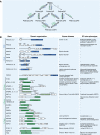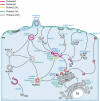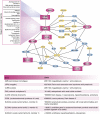Function and dysfunction of the PI system in membrane trafficking
- PMID: 18784754
- PMCID: PMC2536629
- DOI: 10.1038/emboj.2008.169
Function and dysfunction of the PI system in membrane trafficking
Abstract
The phosphoinositides (PIs) function as efficient and finely tuned switches that control the assembly-disassembly cycles of complex molecular machineries with key roles in membrane trafficking. This important role of the PIs is mainly due to their versatile nature, which is in turn determined by their fast metabolic interconversions. PIs can be tightly regulated both spatially and temporally through the many PI kinases (PIKs) and phosphatases that are distributed throughout the different intracellular compartments. In spite of the enormous progress made in the past 20 years towards the definition of the molecular details of PI-protein interactions and of the regulatory mechanisms of the individual PIKs and phosphatases, important issues concerning the general principles of the organisation of the PI system and the coordination of the different PI-metabolising enzymes remain to be addressed. The answers should come from applying a systems biology approach to the study of the PI system, through the integration of analyses of the protein interaction data of the PI enzymes and the PI targets with those of the 'phenomes' of the genetic diseases that involve these PI-metabolising enzymes.
Figures




Similar articles
-
Phosphoinositide-metabolizing enzymes at the interface between membrane traffic and cell signalling.EMBO Rep. 2007 Mar;8(3):241-6. doi: 10.1038/sj.embor.7400919. EMBO Rep. 2007. PMID: 17330069 Free PMC article. Review.
-
Phosphatidylinositol Kinases and Phosphatases in Entamoeba histolytica.Front Cell Infect Microbiol. 2019 Jun 6;9:150. doi: 10.3389/fcimb.2019.00150. eCollection 2019. Front Cell Infect Microbiol. 2019. PMID: 31245297 Free PMC article. Review.
-
Analyzing phosphoinositides and their interacting proteins.Nat Methods. 2006 Apr;3(4):251-8. doi: 10.1038/nmeth867. Nat Methods. 2006. PMID: 16554828
-
PI-loting membrane traffic.Nat Cell Biol. 2004 Jun;6(6):487-92. doi: 10.1038/ncb0604-487. Nat Cell Biol. 2004. PMID: 15170460 Review.
-
The role of the phosphoinositides at the Golgi complex.Biochim Biophys Acta. 2005 Jul 10;1744(3):396-405. doi: 10.1016/j.bbamcr.2005.04.013. Biochim Biophys Acta. 2005. PMID: 15979509 Review.
Cited by
-
The unexpected role of Drosophila OCRL during cytokinesis.Commun Integr Biol. 2012 May 1;5(3):291-3. doi: 10.4161/cib.19914. Commun Integr Biol. 2012. PMID: 22896796 Free PMC article.
-
Endosome maturation.EMBO J. 2011 Aug 31;30(17):3481-500. doi: 10.1038/emboj.2011.286. EMBO J. 2011. PMID: 21878991 Free PMC article. Review.
-
Pairing phosphoinositides with calcium ions in endolysosomal dynamics: phosphoinositides control the direction and specificity of membrane trafficking by regulating the activity of calcium channels in the endolysosomes.Bioessays. 2011 Jun;33(6):448-57. doi: 10.1002/bies.201000152. Epub 2011 Apr 28. Bioessays. 2011. PMID: 21538413 Free PMC article. Review.
-
Coordination between RAB GTPase and phosphoinositide regulation and functions.Nat Rev Mol Cell Biol. 2012 Jun 22;13(7):463-70. doi: 10.1038/nrm3379. Nat Rev Mol Cell Biol. 2012. PMID: 22722608 Review.
-
Lipid binding defects and perturbed synaptogenic activity of a Collybistin R290H mutant that causes epilepsy and intellectual disability.J Biol Chem. 2015 Mar 27;290(13):8256-70. doi: 10.1074/jbc.M114.633024. Epub 2015 Feb 12. J Biol Chem. 2015. PMID: 25678704 Free PMC article.
References
-
- Aoyagi K, Sugaya T, Umeda M, Yamamoto S, Terakawa S, Takahashi M (2005) The activation of exocytotic sites by the formation of phosphatidylinositol 4,5-bisphosphate microdomains at syntaxin clusters. J Biol Chem 280: 17346–17352 - PubMed
-
- Attree O, Olivos IM, Okabe I, Bailey LC, Nelson DL, Lewis RA, McInnes RR, Nussbaum RL (1992) The Lowe's oculocerebrorenal syndrome gene encodes a protein highly homologous to inositol polyphosphate-5-phosphatase. Nature 358: 239–242 - PubMed
-
- Bai J, Chapman ER (2003) Application of fluorescent probes to study mechanics and dynamics of Ca2+-triggered synaptotagmin C2 domain–membrane interactions. Methods Enzymol 360: 238–258 - PubMed
-
- Behnia R, Munro S (2005) Organelle identity and the signposts for membrane traffic. Nature 438: 597–604 - PubMed
Publication types
MeSH terms
Substances
Grants and funding
LinkOut - more resources
Full Text Sources
Other Literature Sources
Molecular Biology Databases
Research Materials
Miscellaneous

